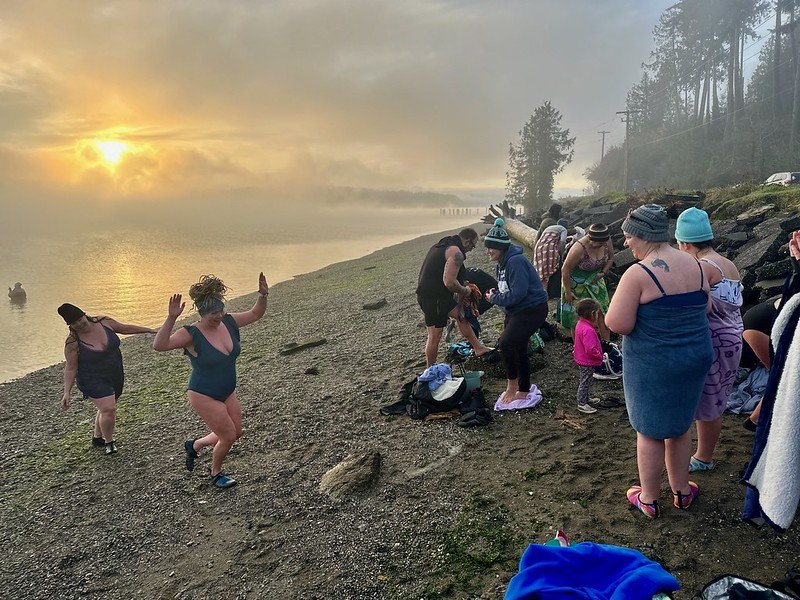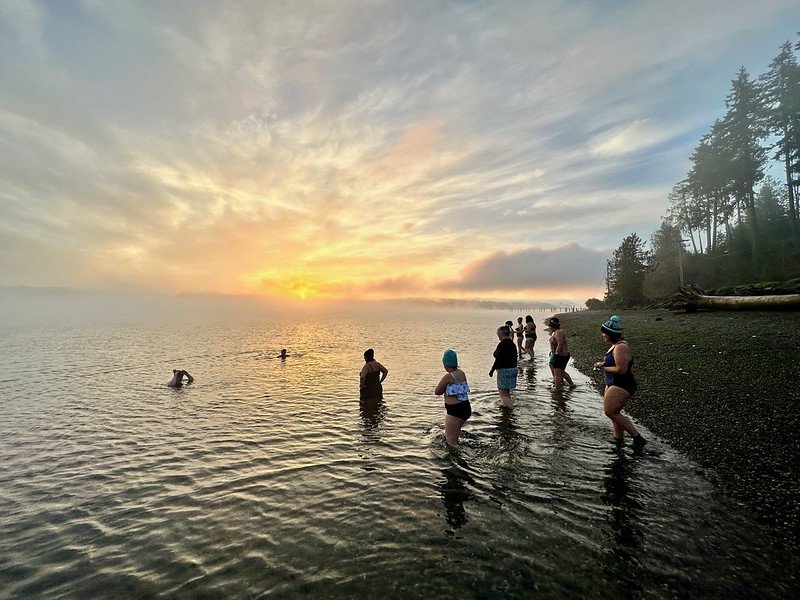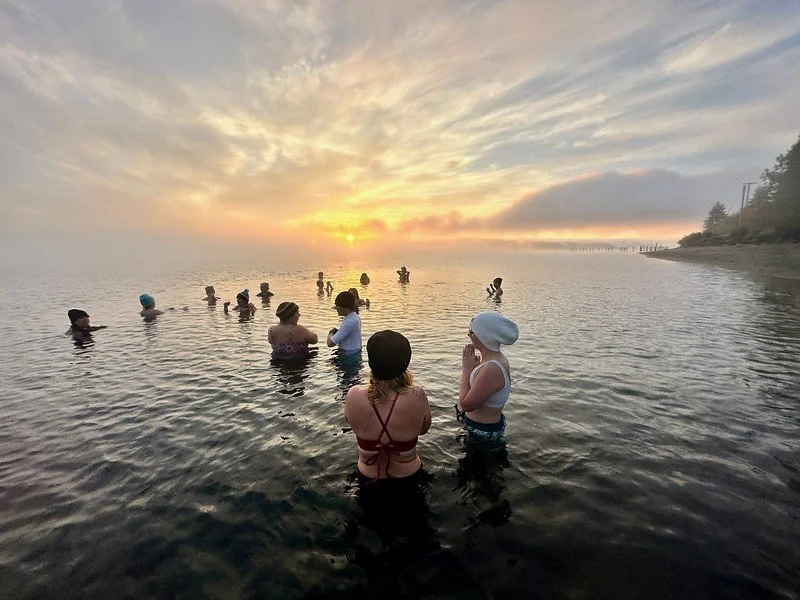thrills & chills
exploring kitsap’s exhilarating cold plunge culture
Words and photos by Joshua Johnson
The Kitsap Peninsula is surrounded by cold water. With 371 miles of shoreline, the peninsula is set like a rough-cut gem in the middle of the Salish Sea. It’s a universe of coves, bays, inlets, estuaries and harbors that unfold in a landscape edged with gravel-strewn beaches and jumbled driftwood. The surrounding sea has been used for transport, fishing and sport for as long as humans have inhabited this land, but average water temperatures ranging from the mid-40's to low-50’s keep most people from going in more than knee-deep on even the warmest days—until recently.
Long held (in many cultures) as good medicine, cold water exposure is having a recent renaissance in the U.S., with influencers and celebrities extolling its virtues and increasing numbers of people embracing practices like ice baths and cold showers for health and well-being. It’s therefore unsurprising that wild cold plunging is increasing in popularity around Kitsap County.
From a group of stalwart cold plungers in South Kitsap to a new sauna + cold plunge business on Bainridge Island, let's dive into the chilly world of cold plunging in Kitsap.
Olalla Bay
47.4223° N, 122.5446° W
Water temp 47°
The sun has not yet risen. A thick blanket of fog flows like a restless specter from the Olalla Creek valley and spreads out over Colvos Passage toward Vashon Island. The Kitsap Wild Swimmers, a Facebook group dedicated to plunging into the waters surrounding the Kitsap Peninsula, gathers in the soft pre-dawn light on a gravel beach of Olalla Bay for a sunrise dip.
I’ve come along and wade in with the group. The cold plunders the warm spaces between my toes. Pebbles crunch underfoot as I draw in a long, slow breath. I try to focus on the peaceful water and growing light in the east, but the contrast between my squishy mammalian warmth and the uncompromising cold of Puget Sound is shocking. All my distractions and daydreams are overridden as cold encircles my waist and inches up my chest. My body instinctively reacts—dumping adrenaline, raising my heart rate and increasing circulation, amid a host of survival responses. Another long breath in and I’m up to my neck.
For 15 minutes, a dozen relative strangers stand and shiver and chat amiably as the first ethereal light of day fills the fog and floods our world with color. A heron sweeps above our heads on some errand. Finally, we get out and dry off and thank each other for being crazy enough to think this was a good idea, let alone a good time. First timers are congratulated.
When the Kitsap Wild Swimmers aren’t neck deep in the Puget Sound, members can often be found warming themselves with a slice of pizza inside the Olalla Bay Market & Landing. I pony up to a table inside the market with a handful of gals who had joined me for the sunrise cold plunge.
During our conversation, common denominators surface: grief, anxiety, pain and a desire to connect. Melina was dealing with the loss of her sister. Lori was living with chronic inflammation. Traci was nursing a broken ankle. Lou was tackling anxiety. All sought the shock of cold water as a way to thrust themselves into the moment amid the challenges of their lives. Scientific research around health benefits of cold therapy supports what the Wild Swimmers know anecdotally: The cold is good for your immune system, metabolism, vascular and mental health. And although many people I spoke to can’t exactly explain the science, they believe it is making them healthier—mind, body and soul.
Traci Belting worked with marine mammals for 40 years, including the belugas at Point Defiance Zoo. After retirement, when she broke an ankle, she had an idea to let the chilly salt water of the Puget Sound work its medicine.
“I just thought of it as my water therapy,” Belting said. “I had spent so much time in the water for my work, it came as second nature, but I didn’t necessarily know it was a thing others were doing as a group. I was hooked the first time. I’m able to truly relinquish control when I get into the water. I did some searching online and I found the Facebook group.”
In a world of warm bodies, finding like-minded people who embrace the challenge and the medicine of the cold is a blessing indeed, especially when there’s pizza after.
Kitsap Wild Swimmers meet for dips at various locations in Central and South Kitsap throughout the week, with Olalla Bay as the unofficial HQ.
Blakely Harbor
47.5994° N, 122.5093° W
Water temp 45.5°
A million overlapping, concentric circles spread across the surface of Blakely Harbor. Flat, gray clouds touch the tops of the evergreens, giving the water a mercurial pall under the steady patter of rainfall.
Once a hub of timber and transport, this quiet little cranny of Bainbridge Island is now a park. It’s also a favorite cold plunging haunt of Sara Otepka and Mikal Foushee, entrepreneurs behind Fire + Floe.
The new Bainbridge Island business offers hot and cold contrast therapy, pairing a high-end mobile sauna experience and natural, cold-water plunges along with strength conditioning and mindfulness. Otepka and Foushee are contrast therapy coaches who lead group classes and experiences that help people build routine, resiliency and a sense of community while connecting to nature.
Fire + Floe’s one-hour HiLoFlo classes (launching in March) bring a mobile sauna (and changing room) to locations like Blakely Harbor Park so participants can experience the heat of the sauna and the cold of the Puget Sound with coaches and community present for instruction and support. The unique offering is a first for our region. At-home ice baths and cold showers are good for building cold tolerance and achieving benefits, but there’s something special about connecting to nature by placing your body in a truly wild place like the sea.
On this rainy morning, Foushee, Otepka and I forgo the sauna and get right into the water. The other two are daily cold plungers but as we enter the water, I’m a little relieved when they confide, “it’s cold every time, even if you do it every day.”
Building a cold plunge practice doesn’t make the water less cold but, as they demonstrate, it does make people mentally and emotionally stronger. The word that comes up over and over in these conversations is resilience. People don’t get less cold. They get more resilient. Some may want or need coaches to help guide them through the process. That’s where Fire + Floe comes in.
Otepka comes from a professional background in the health and wellness space and sees the model of Fire + Floe as a perfect fit for the Peninsula’s outdoor culture. Kitsap has pristine natural environments, a wealth of public beach access points and an adventurous, nature-loving ethos centered on experiences like hiking, paddling, camping, mountain biking ... and cold plunging.
Otepka and Foushee feel called to help connect people to nature and their own inner strength and to help support a thriving culture on Kitsap around cold plunging and contrast therapy.
Funny thing about cold plunging in the rain, you forget it’s even raining.



Visit fireandfloe.com for information on group plunges, weekly classes, half- or full-day tailored experiences and individual coaching.
5 more places to cold plunge in kitsap
Appletree Cove: This sandy, little park in Kingston overlooks the ferry terminal and is a great place to picnic.
Guillemot Cove: Tucked away in the wilds of Seabeck, this enchanted Hood Canal cove is an adventure unto itself.
Kitsap Memorial State Park: A Hood Canal soak spot with amazing sunsets and good park facilities to boot.
Manzanita Bay at Dock Street: This small, sandy beach and Bainbridge Island road end is popular among swimmers, paddlers and plungers, offering spectacular sunsets and Olympic range views.
Point No Point Park: Ths iconic Hansville beach is a sandy stretch of PNW paradise.
cold plunging 101
Cold water exposure may have health benefits, but it also has inherent risk. Here are a few tips to help make your cold plunges safer and more comfortable.Wear proper footwear. Barnacles and bare feet are not good bedfellows. Wear water shoes, sandals or sneakers in the water to protect your feet from anything sharp below the surface.
Check the tides and conditions. Download a tide app or find tidal flows and conditions online so you know what you’re getting into.
Layer up to warm back up. Make sure you have a cozy coat or blanket as well as a towel and plenty of layers to warm back up. Crank the heat in your car and pour something warm to sip into that Stanley.
Listen to your body. It’s best not to exceed 15 minutes in the cold water. Listen to your body and get out sooner if you need to. A few minutes in the cold goes a long way.
Bring a friend. The buddy system is often a good idea and cold plunging is no exception. Having a friend to talk to can also help pass the time.

